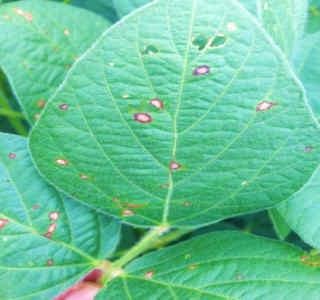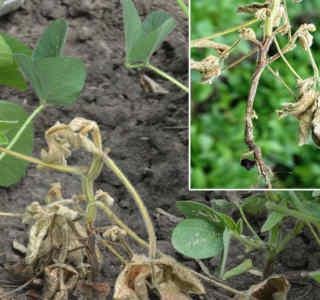Scouted soybeans have been flowering and some soybeans are nearing the R3 (beginning pod) to R4 (full pod) growth stage. Even though it has been hot and humid, some areas of the state have received some rainfall, which has set up soybeans for disease development. Common soybean diseases you may find while scouting include Septoria brown spot, Cercospora leaf blight, frogeye leaf spot, phytophthora root rot, stem canker and white mold.
Figure 1. Brown spot symptoms on a soybean leaf.
Cercospora Leaf Blight/Frogeye Leaf Spot

Figure 2. Frogeye leaf spot lesions on a soybean leaf. Notice the gray center and a dark-brown reddish margin. Courtesy: E. Byamukama
Frogeye leaf spot, also known as Cercospora leaf spot, lesions (irregular to circular lesions, which are tan-to-gray in color with reddish-purplish borders) develop in young, expanding leaves in the top of the canopy and may coalesce (grow together) to form larger spots (Figure 2). Continued disease development will lead to premature leaf drop. Frogeye leaf spot symptoms can also develop on pods and stems. This disease is usually observed after the R1(beginning flower) growth stage, and its development is favored by frequent rains and warm conditions. This fungal pathogen survives on crop residue and can also be seed transmitted. Fungal spores are spread by rain splash and the wind.
The best time to apply a foliar fungicide is between the R3 (beginning pod) to R5 (beginning seed) growth stages. Other management includes: selecting resistant cultivars, crop rotation, tillage (where practical) to remove or reduce the source of inoculum.
Phytophthora Root Rot

Figure 3. Chocolate brown lesion extending up the soybean plant from the soil line. Courtesy: E. Byamukama
Phytophthora is most common in heavy, compacted clay soils, which are subject to saturation and flooding, which is why symptoms are often found in low spots and field entrances. The fungal pathogen that causes phytophthora overwinters in the soil and on infected soybean residues as oospores. Infection can take place before seedling emergence, which causes pre-emergence damping off, or infection can take place after seedling emergence and later in the season. Plants stressed by moisture, compaction or nutrient stress may exacerbate the phytophthora symptoms. Phytophthora is identified by the chocolate brown lesion starting at the soil line of the plant and moves up the stem (Figure 3).
Phytophthora can be managed by planting resistant cultivars, drainage, seed treatment (active ingredients mefenoxam or metalaxyl), and crop rotation (to reduce the level of inoculum).
Stem Canker

Figure 4. Close-up of soybean plant with stem canker symptoms. Notice the green tissue above and below the brown lesion. Courtesy: E. Byamukama
Stem canker symptoms begin as small, reddish-brown lesions on the lower nodes of the plant. The lesions expand up and down the stem, causing the lesions to girdle the stem, causing the plant to wilt and die (Figure 4).
The fungal pathogen survives in infested crop residues and soil. Spores are moved onto young soybean plants by rain splash, but symptoms usually develop after flowering.
Stem canker management includes use of resistant varieties, rotating soybean to a non-host (e.g. corn, wheat), tillage practices and maintaining adequate fertility.
White Mold

Figure 5. Soybean plant showing typical white mold signs: white mycelia and sclerotia in the middle canopy. Courtesy: E. Byamukama
White mold development is favored by frequent rains and overcast conditions. White mold is a fungal pathogen, which overwinters as a hardened fungal mass called sclerotia in the soil and soybean stem residues. By the time white mold symptoms (white mycelia and the formation of sclerotia) are seen in the field (Figure 5), it is too late to apply a fungicide. The infected plants will not be able to recover. Therefore, white mold is one those diseases where a fungicide is applied prior to the disease symptoms onset.
The extent of white mold development in a field is dependent on: field history of white mold, narrow row spacing/high planting population (>160,000 seeds per acre), susceptible cultivar, high soil fertility environment and conducive weather. Field history is important because white mold sclerotia can remain active in the field; specifically, where tillage is practiced. Narrow row spacing and high planting population provide early canopy closure. The shade, provided by the closed canopy, lowers the temperature underneath the canopy, which stimulates the sclerotia to start producing spores. Fields with high soil fertility levels, particularly where animal manure was applied, tend to have increased white mold risk. Variety white mold rating also influences the level of white mold development. Fields with a few of these risk factors; especially, history of white mold in the past, may consider applying a fungicide to control white mold at the R1 growth stage.
The only in-season white mold management practice is the application of fungicides. To obtain the maximum benefits from a fungicide application, the time of application and type of fungicide to be applied are important. The best fungicide application timing for white mold protection is the R1 growth stage (beginning flowering). This application timing will protect the initial flowers from infections to take place. Fungicides that have been found to be effective against white mold include: Aproach, Domark, Endura, Omega500DF, Propulse and Proline. Other management options prior to planting include: crop rotation, wider row spacing (>20 inches), planting tolerant varieties and avoiding excessive nitrogen fertilizers, such as animal manure.
When is the best time to apply foliar fungicide?
The R1 (beginning flowering) stage of growth is recommended for white mold prevention. The R3 to R4 growth stage is recommended for other foliar fungal diseases, such as Septoria brown spot, Cercospora leaf blight and frogeye leaf spot. If a fungicide is determined to be needed, there are several fungicides available on the market that are effective against the common foliar diseases in soybeans. Please see the most-recent SDSU Extension Soybean Pest Management Guide and the Fungicide Efficacy for Foliar Soybean Diseases publication developed by Plant Pathologists in the North Central Region for available fungicides.
Source :